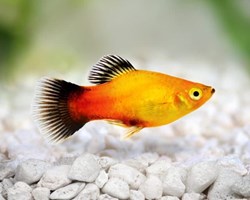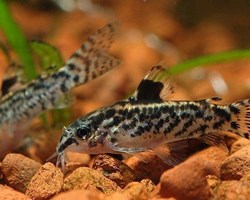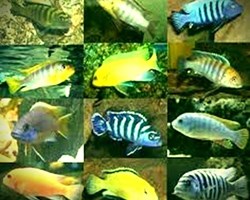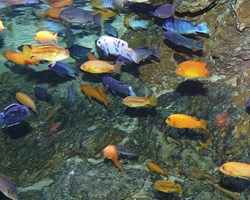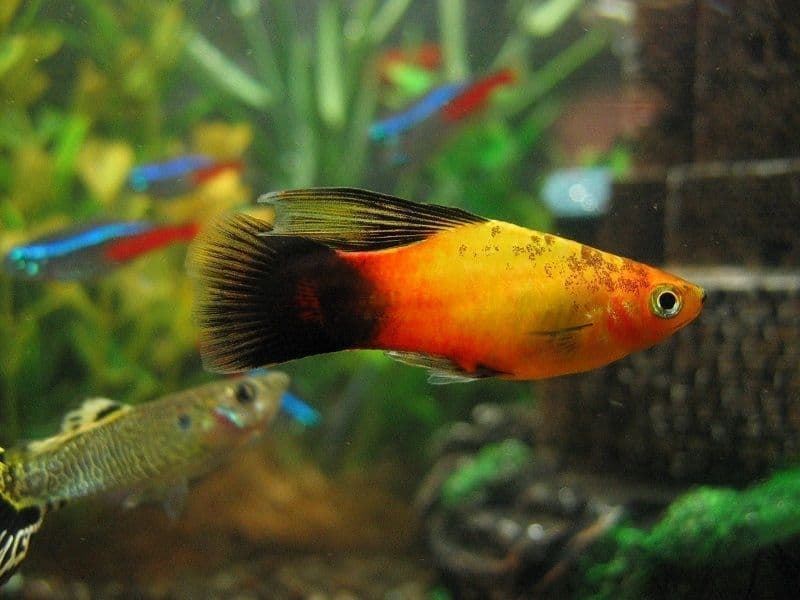
PLATY FISH DESCRIPTION:
Platy fish, Xiphophorus maculatus, is very popular among aquarium enthusiasts as well as other fish of the poeciliidae family, also very easy to care for, such as guppies or mollies.
The variety of platy fish on the market is huge.
Within the different existing varieties, the most popular are:
- Coral. Platy fish of red or orange color.
- Sunset. Bicolor Platy fish.
- Wag-tail. Platy fish with one or two colors, except for the fins that are black.
- Blue. Platy fish of bluish color, with some reflections in golden color.
- Mickey. Platy fish with a caudal fin in which we can find three black spots, slightly reminiscent of Mickey Mouse.
- Tuxedo. Platy fish of different colors, but with a characteristic black stripe.
- Kite. Platy fish with a caudal fin clearly marked by two black stripes on the edges.
- Spotted. Platy fish, which is also popularly called salt and pepper. Its body is covered with small black dots.
- Moon. Platy fish that goes from pink or orange to red. It has a round spot on its pendulum, in addition to carrying the drawing of Platy Mickey Mouse, although without the spot on its rear fin.
- Calico. Bicolor Platy fish. One of the shades covers the front of the fish, and the other covers the back. The red and yellow Calico Platy are called sunset.
- Pineapple. Platy fish yellow in its entirety, except for the brown head.
Normally the females tend to be larger and the males usually have a slightly more intense color and a reproductive organ, you can tell the males from the females just by looking at them.
The platy can measure up to 6 cm.
The males are smaller: 5 cm and have a greater coloration.
In the male, the anal fin has been transformed into a copulatory organ called a gonopodium.
The females are larger; 7 cm and have a less intense coloration.
Males are significantly smaller than females and have a more streamlined shape.
They have the anal fin transformed into a gonopodium and it is quite normal for them to have a more intense coloration.
Females, on the other hand, are twice the size of males and have a more rounded body.
The anal fin is clearly visible.
The platy is characterized by having the profile of the belly more convex than the back, the dorsal fin is large and has 10 to 12 spiny rays.
The typical colors of their body are combinations of yellowish, orange, greenish or bluish tones and they have an irregular drawing forming black dots.
The caudal fin is usually orange or reddish, while the rest of the fins are a yellowish-green hue. Its ventral region can be silver or gold.
There are several hybrids achieved in aquariums, as well as very diverse color varieties.
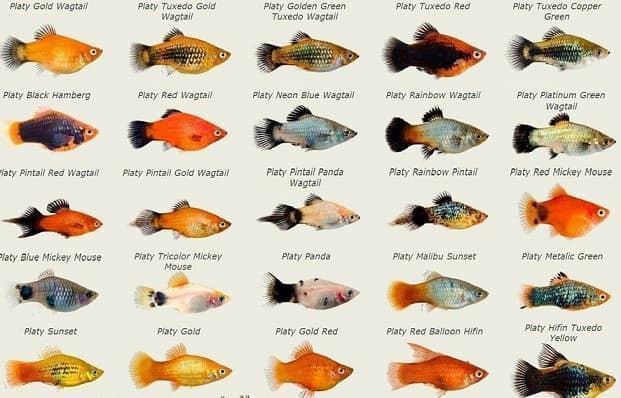
In the wild, the Platy fish is usually olive in color, however the colorations available for sale, as I have mentioned, are enormous.
They usually measure between five and six centimeters, being the male; 3.5 cm., somewhat smaller than the female; 6 cms., which is usually larger and rounded.
Platy females can be distinguished from males because the latter have a reproductive organ, called a gonopodium, a tube-shaped modification of their anal fin.
They have an elongated shape, in which the belly is more convex than the back of the fish. The mouth of the fish is oriented upwards, typical of fish used to eating from the surface.
There are two types of Platy fish, those with a veil fin, which is nothing more than a more developed dorsal fin, and those with a needle tail, very similar to that of the swordtail fish.
Platy fish or sunfish with its scientific name Xiphophorus maculatus, is one of the most popular and easy to care for freshwater fish compared to other species of tropical fish.
They are fish that attract attention for their incredible bright and fun colors.
It is generally a freshwater fish, but they can be found in small rivers, puddles, as long as the water is kept fresh and in good conditions for them.
Whether you already have knowledge of the world of aquarium hobby or you are just starting out, the Platy fish will always be an ideal tropical fish for your aquarium.
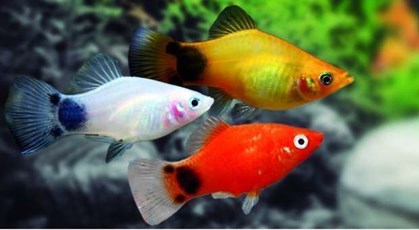
FOR THE BEST CARE YOU MUST KNOW ITS DISTRIBUTION AND HABITAT:
The natural habitat of the Platy is in the calm waters of streams and rivers, in the coastal regions of Mexico, Guatemala, Nicaragua and Belize.
The habitat of the platy is the rivers of Central America.
The three species of Platies inhabit different rivers in South America:
The Southern Platy inhabits the fresh waters of Mexico, Guatemala and northern Honduras.
The Variable Platy is native to the waters of southern Mexico, from the Panuco River to the Cazoneses River.
Swordtail Platy is only found in the Rio Soto La Marina river system in Mexico.
The platy comes from the southern part of Mexico and northern waters of Guatemala and Honduras.
Practically all of the varieties that we can get in stores come from selective breeding in captivity. (
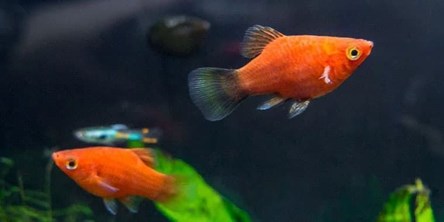
THE BEST CONDITIONS OF THE AQUARIUM:
The Platy fish needs an aquarium of about 80 liters, well planted and with a temperature between 20º C and 26ºC. The pH of the water must be maintained between 7 and 8.2.
They occupy the upper space of the aquarium, they are surface swimmers, which is where they usually find their food.
The abundance of vegetation, among which surface plants must be included, is because they need a certain privacy, they are somewhat shy fish by nature.
Platy fish are hardy and tolerate a wide range of water conditions, hence their difficulty is easy, but try to have regular water changes with 25% changed every week.
Your platy fish will be most comfortable in an aquarium that mimics their natural habitats with a planted tank and gravel substrate, although this can also vary with the species. A highly recommended plant would be the Java Fern or the Anubias.
The temperature of the water changes slightly depending on the variety you have. Your colors will look best if you keep the temperature in the cooler range.
We recommend that your aquarium meets these requirements:
- The temperature should be between 18 to 28 ºC.
- The pH of the water should be between 6.8 and 8.0.
- And the GH (hardness) from 10 to 28 ºGH.
- Feed 1 or 2 times a day.
- Weekly water changes of min. 25%.
Hornbeam, Java moss, and duckweed are all good plants to use.
In general, Flounder are hardy fish and can tolerate a wide range of water conditions, however, Swordtails are sensitive to poor environments. Try to have regular water changes, with a 25% change every 2 weeks.
Your platy fish will feel most comfortable in an aquarium that mimics their natural habitats with a heavily planted tank and a gravel substrate.
Plants can be arranged differently depending on the species you have. While the southerner prefers a free-standing aquarium, the variable prefers a densely planted tank with open swimming spaces.
The temperature of the water changes slightly depending on the variety you have. The Common and Swordtail prefer 70-70°F, while the Variable prefers 72-75°F. Their colors will look better if you keep the temperature in the cooler range.
They all prefer weak currents with a water pH of 6.8-8 and a water hardness of 10-28 dGH. As small active fish, platy fish need a tank size of at least 10 gallons.
At Glu Glu pet we recommend the following products:
- Aquarium Kits.
- Filters and filter loads.
- heaters.
- Thermometers.
- inert substrates.
- Fertilizer substrates.
- rocks.
- logs.
- Ornaments.
- Aerators and accessories.
- Conditioners.
- Anti-algae and fertilizers.
- Cleaning.
- Test analysis.
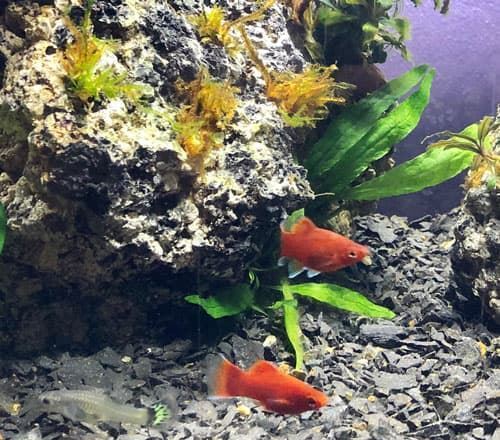
THE BEST NUTRITION FOR YOUR PLATY FISH:
The Xiphophorus maculatus is an omnivorous fish, it will accept any type of specific dry food, although live or frozen insects, crustaceans and vegetables should be included in its diet.
If the aquarium is shared with other species, we will be careful that they eat enough, since they are quite passive and will not fight for food.
You should feed your fish once or twice a day, and only as much food as they can eat in two minutes. For example you can feed it with scales for exotic cold water fish.
Platys are tropical fish and are considered omnivorous, but have a substantial need for herbivorous food.
An ideal diet should be a healthy mix of protein and vegetables. Flakes and other prepared fish foods are great for them as long as they are high in protein.
When it comes to live food, they enjoy bloodworms, daphnia, brine shrimp, mosquito larvae.
You can feed your adult platies 2 or 3 times a day, be careful not to overfeed them, because these fish love to eat, for young fish you can feed them 4 to 5 times a day with small portions, so that they reach maturity and desired color very quickly.
The platy is a voracious, omnivorous fish that accepts a wide variety of foods. Likes worms, crustaceans, insects, plant matter, dried food, flakes. The ideal is to alternate the different types of food. They love live prey, although they do not disdain dried food and vegetables.
At Glu Glu Pet we recommend the following products:
FOR YOUR BEST CARE YOU MUST KNOW YOUR BEHAVIOR AND COMPATIBILITY:
It is a very peaceful species, they are not aggressive towards any other species. We can see them moving throughout the day, almost non-stop.
They are a gregarious species, we need to introduce a small group in the aquarium, so that the health conditions are optimal.
In this sense, at least three females must be introduced for each male, so that we will reduce the risk of rivalry between the males, who usually face each other for the females during the mating season.
Platy fish are active, quiet little fish that are much happier when in small groups of the same species.
Platy will spend most of their time in your aquarium swimming in small groups in the middle of the water column, among plants and hiding among floating leaves.
They are not usually aggressive, but it is possible for the males to annoy the females if you do not maintain the correct male-to-female ratios.
Remember that if the female is overwhelmed by the behavior of the males, she could jump out of the tank.
Platy Compatible Fish:
They coexist very well with fish with which they share size, temperament and require similar aquarium conditions:
- Mollies.
- Swordtail fish or Guppies.
- Swordtails,.
- Snails.
- Prawns.
As it is a fish that swims on the surface, you can look for others that use the rest of the aquarium, such as the corydoras that occupy the lower part.
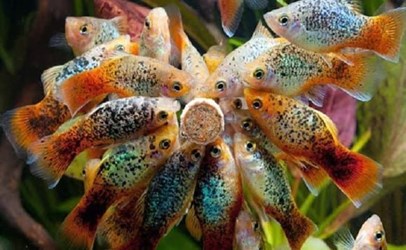
THE REPRODUCTION OF PLATY FISH:
The Xiphophorus maculatus reproduces easily, even in a community aquarium where it shares space with other fish.
For a higher success rate and although they do not usually eat their young, if we want to breed Platy fish we should separate the pairs at the time of spawning, so that once it has occurred, remove the adult fish.
Another reason to keep a breeding tank is that in the previous days, the male is usually somewhat aggressive and can disturb other fish with his courtship.
The pregnant Platy will have a gestation period of between 4 and 6 weeks, to produce up to 80 fingerlings in each clutch.
Platy fish love to breed, they are ovoviviparous: the young are incubated in the female in her womb and their gestation lasts approximately one month. Once you release the fish, they are already free swimming, ready to feed and be independent, they will usually try to hide among the plants in your aquarium to protect themselves from larger fish.
Platinum fish are also known as live fish. These fish are known to keep the eggs inside their bodies until they are ready to give birth to free-swimming fry.
These fish are prolific breeders. You won't have to do much, just keep two fish of the opposite sex in the same tank for them to breed.
It is quite difficult to determine the opposite sexes until they reach maturity at 4 months. At this point the sexual dimorphism is quite obvious. Sexual dimorphism is the difference in size and appearance between the sexes of the same species.
Female Platys are generally larger and flatter when fully grown. The males take a while to reach their full coloration, and as they grow the anal fins take on a rod shape, which is known as their reproductive organ gonopodium.
Flounder are likely to eat their fry, therefore we suggest using a breeding tank of about 12-20 gallons with filtration.
If you are breeding in the community aquarium, be sure to provide enough hiding spaces with dense plants so the fish can find shelter.
Generally, females can have up to 80 fry. They are normally pregnant for about 24-30 days before giving birth to live young. They are born ready to swim and you can feed them egg yolk, dry food and specific food for the fry.
The platy is a very prolific fish, very easy to reproduce in a community aquarium.
It is recommended that the reproduction aquarium be prepared with a side area with more vegetation, where the female can take shelter from the rest of the fish and the fry can hide.
Their way of reproduction is a miracle of adaptation.
These fish are born perfectly formed and do not go through the embryo stage inside an egg on the outside.
In this way, they minimize the risk of the eggs being eaten by predators.
Platy reproduction begins when the male displays his fins and performs courtship with the female.
If the female is receptive, she will stop and stay still for a few seconds, this will allow copulation and the transmission of the sperm through the spermatophores, the package where the sperm go.
Females close to giving birth are characterized by their large bellies and an extensive black spot on the ventral-anal area.
The females of the platy are viviparous. During gestation they must be changed to another aquarium.
After four or six weeks the female gives birth.
At the moment of giving birth, the female retires to a secluded place where she can take refuge and there she gives birth. from 10 to 80 live fry, they are born already formed and self-sufficient.
Platys, including their mother, tend to eat their young.
These newborns only take a few moments to seek refuge, swimming like an expert.
Nature has endowed them with independence from the first day of life, which makes them safe from many predators.
The fry are not picky about their diet as they readily accept crushed flakes. The fry can reach sexual maturity after 6 to 8 months.
THE BEST CARE FOR PLATY FISH:
It is a very peaceful species.
You can keep it with most of the species in a community aquarium.
They do not exhibit the aggression of some Xipho and Mollys, and even the males tolerate each other.
When males and females share the same tank, you will need to have more females to disperse the males' attention, which can be unforgiving.
The fry litters will be continuous.
It is an aquarium species with dozens of selectively bred varieties, including the Mickey Mouse Platy, Tuxedo Platy in various colors, blue, red, gold, balloon varieties and different types of tails. Some of them are produced by crossing with X. helleri or X. variatus.
Unfortunately, many commercially bred Platys are not very hardy due to inbreeding and overproduction and are prone to disease and early death.
It is unusual to see wild specimens in the hobby because they are less colorful than the versions obtained through selective breeding.
In its original wild state, the Platy is grayish brown to olive green in color with slight sheens. As long as you keep the pH above 7, this fish is one of the best species available for the beginner.
To accommodate the platy a fish tank of more than 40 liters is recommended.
The aquarium must be 30 cm long so that the fish can move freely.
The water should not be very hard and slightly alkaline and no salt should be added.
These specimens can be kept in an aquarium with bright lighting, a dark background and dense vegetation, not too high a layer of sand and aquatic vegetation that occupies half the container that the platies like, and not too high cover. A regular and partial renewal of the water must be carried out.
These fish can be without heating, I recommend 24 to 26 degrees.
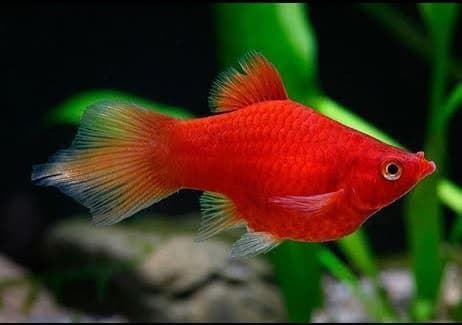
PLATY FISH HEALTH:
There are many treatments, from raising the temperature of the water to using medication.
Flounder are hardy little fish and are not prone to any particular disease. However, they can fall victim to common tropical fish problems like Ich and Fin Rot.
Fish diseases are not always easy to detect. You will probably notice a different behavior or some bumps on your skin and body, depending on the stage you recognize them, the disease will be more or less difficult to treat.
Ich disease is one of the most common diseases in the aquarium hobby. It is a parasite that causes white spots on the body, gills and fins. If not cured, it can cause serious infections and respiratory damage to fish.
Fin Rot is another common disease caused by bacterial infection of the tails or fins. Antibiotics are usually the best options, such as Chloromycetin or Tetracycline. You can add them while feeding your fish.
The best thing you can do is try to proactively prevent disease by maintaining good quality water and a healthy, balanced diet. Reducing the stress level is essential for your fish and you can do this by giving them the best possible environment. Stressed fish are more likely to get sick.
Other articles that may interest you:

